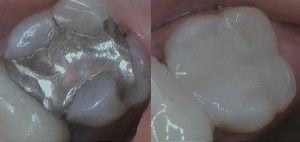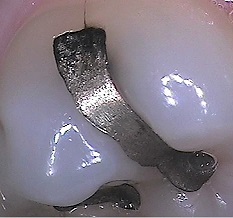Restorative dentistry is the study, diagnosis and integrated management of diseases of the teeth and their supporting structures and the rehabilitation of the dentition to functional and aesthetic requirements of the individual.
There are various types of fillings for different dental conditions. When you need a dental filling we help you decide the right type of filling based on the location and depth of the decay, the cost of the filling, and your insurance coverage.
Some common types of fillings are as follows:
• Composite: Tooth-colored material or Composite are popular because the color can be matched with the color of your teeth. Composites are more expensive than amalgam fillings, although not as expensive as gold fillings.
Advantages of Composite Fillings:
• Tooth Colored.
• Maximum amount of teeth preserved.
• Does not corrode.
• Resistance to further decay is moderate and easy to find.
• Strong and durable, resists breaking.
Disadvantages of Composite fillings:
• Moderate occurrence of temporary tooth sensitivity.
• Costs more than dental amalgam.
• Material shrinks when hardened and could lead to temperature sensitivity.
 • Amalgam. Dental amalgam is a self-hardening mixture of silver-tin-copper alloy powder and liquid mercury and is sometimes referred to as silver fillings because of its color. Many people don’t like the look of the silver amalgam fillings. Also, amalgam fillings can be more prone to expansion and contraction, thus they are more likely to cause a tooth to crack compared with other filling materials.
• Amalgam. Dental amalgam is a self-hardening mixture of silver-tin-copper alloy powder and liquid mercury and is sometimes referred to as silver fillings because of its color. Many people don’t like the look of the silver amalgam fillings. Also, amalgam fillings can be more prone to expansion and contraction, thus they are more likely to cause a tooth to crack compared with other filling materials.
Advantages of Amalgam fillings:
• Relatively inexpensive
• Generally completed in one visit
• Strong and resist breaking
Disadvantages of Amalgam Fillings:
• Gray color, not aesthetic
• May darken as it corrodes; may stain teeth over time
• Requires removal of some healthy tooth Structure
• In larger amalgam fillings, the remaining tooth may weaken and fracture
• Because metal can conduct hot and cold temperatures, there may be a temporary sensitivity to hot and cold.

• Gold. Gold fillings are sturdy and non-corrosive; they can last up to 15 years. But gold fillings can cost as much as five times more than composite fillings, and it takes more than one office visit to fit them properly.
Advantages of the Gold Fillings:
• Excellent durability; does not fracture under stress.
• Does not corrode in the mouth.
• Minimum amount of tooth needs to be removed.
Disadvantages of the Gold Fillings:
• Color is yellow.
• Conducts heat and cold; may irritate sensitive teeth.
• High cost.
• requires at least two office visits.
• Glass ionomers. These glass and organic acid fillings are softer than regular composite. Glass ionomer is usually used for small fillings, cementing metal and metal ceramic crowns, as a Base for the other types of filling materials, and temporary restorations.
Advantages of the Glass Ionomer Fillings:
• May provide some help against decay because it releases fluoride.
• Bonds well to both the enamel and the dentin.
• Material has low incidence of producing tooth sensitivity
Disadvantages of the Glass Ionomer Fillings:
• Limited use because it is not recommended for biting surfaces in permanent teeth
• May become rough and could increase the accumulation of plaque and chance of periodontal disease
